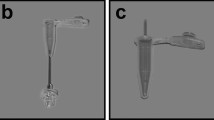Abstract
The investigation of human tear film proteins and lipids is of value for the elucidation of contact lens incompatibilities, tear film instabilities, dry eye syndrome and various other eye diseases. Improved efficient methods for the investigation of human tear film proteins and lipids are presented in this paper. Tear proteins were examined by ultrathin sodium dodecyl sulfate-polyacrylamide gel electrophoresis, celluloacetate gel, isoelectric focusing, and high-performance liquid chromatography. The methods differ in sensitivity, resolution, convenience and reproducibility. Tear lipids were examined by high-performance thin-layer chromatography, and good separation into the major lipid classes was achieved. With this method it is possible to examine the lipids present in tears of an individual subject and not just in pools made up from the tears of several persons.
Similar content being viewed by others
References
Andrews JS (1970) Human tear film lipids. I. Composition of the principal non polar component. Exp Eye Res 10:223–227
Baier G (1986) Isolierung und Charakterisierung ribosomaler Proteine aus dem Archaebacterium Methanococcus vannielii. Diplomarbeit, Universität Innsbruck
Baier G, Wollensak G, Mur E, Redl B, Göttinger W, Stöffler G (1989) Analysis of tear proteins by different high performance liquid chromatography techniques. J Chromatogr Biomed Applic (in press)
Bonavida B, Sapse AT, Sercarz EE (1969) A unique lacrimal protein absent from serum and other secretions: specific tear prealbumin. Nature 221:375–377
Boonstra A, Kijlstra A (1984) Separation of human tear proteins by high performance liquid chromatography. Curr Eye Res 3:1461–1469
Bowers RWJ, Tighe BJ (1987) Studies of the ocular compatibility of hydrogels. White spot deposits — chemical composition and geological arrangement of components. Biomaterials 8:172–176
Bradford M (1976) A rapid and sensitive method for the quantitation of microgram quantities of protein utilizing the principle of protein-dye binding. Anal Biochem 72:248–254
Chemetron (1987) Instructions for use of cellogel. Milan, Italy
Chemetron News No. 10 (1987) Electrophoresis of unconcentrated urine and CSF proteins. Milan, Italy
Doughman DJ, Mobilia E, Drago D, Havener V, Gavin M (1975) The nature of “spots” on soft lenses. Ann Ophthalmol 7:345–353
Ehlers N (1965) The precorneal tear film. Acta Ophthalmol [Suppl] 81:1–136
Gachon AM, Verrelle P, Betail G, Dastugue B (1979) Immunological and electrophoretic studies of human tear proteins. Exp Eye Res 29:539–553
Gachon AM, Lambin P, Dastugue B (1980) Human tears: electrophoretic characteristics of specific proteins. Ophthalmic Res 12:277–285
Gachon AM, Richard J, Dastugue B (1983) Human tears: normal protein pattern and individual protein determinations in adults. Curr Eye Res 2:301–308
Görg A, Postel W, Weser J, Schiwara HW, Boesken WH (1985) Horizontal SDS electrophoresis in ultrathin pore-gradient gels for the analysis of urinary proteins. Sci Tools 32:5–9
Haberich FJ (1982) Der praekorneale Tränenfilm (PKTF). Dtsch Opt Ztg, pp 24–33
Hames BD, Rickwood D (1981) Gel electrophoresis of proteins. A practical approach. IRL Press, Eynsham, Oxford
Hart DE, Tidsale RR, Sack RA (1986) Origin and composition of lipid deposits on soft contact lenses. Ophthalmology 93:495–503
Kilp H (1986) Pathophysiologie des präkornealen Films: Lipidschicht. Fortschr Ophthalmol 83:122–124
Kupke IR, Zeugner S (1978) Quantitative high-performance thin-layer chromatography of lipids in plasma and liver homogenates after direct application of 0.5 µl samples to the silica gel layer. J Chromatogr 146:261–271
Liotet S, Warnet VN, Arrata M (1982) Functional exploration of the lacrimal gland by tear electrophoresis. Ophthalmologica 184:87–91
Liotet S, Murat AF de, Schroeder A, Cochet P, Warnet VN, Moens C (1983) Beschleunigte Verschmutzung von Hema-Kontaktlinsen durch Tränenanomalien. Contactologia 5 D:12–15
Liotet S, Warnet VN, Glomaud J, Mellet J, Laroche L (1984) Diagnose von Augenkrankheiten durch die Tränenflüssigkeit. Contactologia 6D:147–152
Lundh RL, Liotet S, Pouliquen Y (1984) Study of the human tear barrier and the biochemical changes in the tears of 30 contact lens wearers (50 eyes). Ophthalmologica 188:100–105
Mackie IA, Seal DV (1984) Diagnostic implications of tear protein profiles. Br J Ophthalmol 68:321–324
Mayr AM (1987) Elektrophoretische und immunelektrophoretische Untersuchung von Tränenflüssigkeit gesunder Probanden. Dissertation, Universität Innsbruck
Merril CR, Goldman D, Sedman SA, Ebert MH (1981) Ultrasensitive stain for proteins in polyacrylamide gels shows regional variation in cerebrospinal proteins. Science 211:1437–1438
Mur E, Kieselbach G, Göttinger W, Stöffler-Meilicke M, Stöffler G (1987) Elektrophoretische und immunelektrophoretische Analyse der Tränenproteine. Spek Augenheilkd 1:97–99
Refojo MF, Holly FJ (1977) Tear protein absorption on hydrogels: a possible cause of contact lens allergy. Contact Lens 3:23–35
Segura R, Gotto AM (1974) A new fluorometric procedure for the detection and quantitation of organic compounds in thin-layer chromatography. J Chromatogr 99:643–657
Sen DK, Sarin GS (1982) Immunoassay of tear lysozyme in conjunctival disease. Br J Ophthalmol 66:732–735
Serva (1987) Arbeitsanleitung für die Lipoproteintrennung. CAF/3. Heidelberg, FRG
Stöffler G (1967) Ribosomal proteins II. A rapid micromethod for electrophoretic separation ofEscherichia coli ribosomal protein on gelatinized cellulose acetate. Mol Gen Genet 100:374–377
Tiffany JM (1978) Individual variations in human meibomian lipid composition. Exp Eye Res 27:289–300
Towbin JM, Staehelin T, Gordon J (1979) Electrophoretic transfer of proteins from polyacrylamide gels to nitrocellulose. Proc Natl Acad Sci USA 76:4350–4354
Van Haeringen NJ (1981) Clinical biochemistry of tears. Surv Ophthalmol 26:84–96
Wolff E (1946) Mucocutaneous function of the lid margin and the distribution of the tear fluid. Trans Ophthalmol Soc UK 66:291–308
Zöllner N, Kirsch K (1962) Über die quantitative Bestimmung von Lipoiden (Mikromethode) mittels der vielen natürlichen Lipoiden (allen bekannten Plasmalipoiden) gemeinsamen Sulfophosphovanillin-Reaktion. Z Ges Exp Med 135:545–561
Zubke W, Stadler H, Ehrlich R, Stöffler G, Wittmann HG (1977) Improved electrophoretic and immunochemical techniques for the identification and characterization of mutant proteins, applied to ribosomal protein S8 inEscherichia coli mutants. Mol Gen Genet 158:129–139
Author information
Authors and Affiliations
Rights and permissions
About this article
Cite this article
Wollensak, G., Mur, E., Mayr, A. et al. Effective methods for the investigation of human tear film proteins and lipids. Graefe’s Arch Clin Exp Ophthalmol 228, 78–82 (1990). https://doi.org/10.1007/BF02764296
Received:
Accepted:
Issue Date:
DOI: https://doi.org/10.1007/BF02764296




